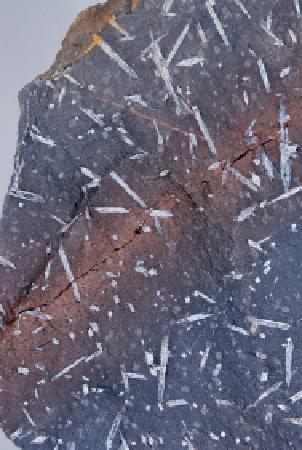Geoscience Reference
In-Depth Information
Reaction zones
Zones marked by colour (and mineral) changes may refl ect local
metasomatism, for instance by hot fl uids penetrating along
cracks (Figure 9.7), or moving through the rock as a fl uid
front.
9.3 Mineralogy
9
9.3.1 Identifying common metamorphic
minerals
Some minerals are easily identifi ed in the fi eld, but many
minerals vary in their appearance from rock to rock. If in doubt
about their identity, note their properties (colour, shape, lustre,
cleavage, etc.) and sketch examples. You may need to adopt
various strategies to collect the information, such as:
describing the appearance of weathered grains (a weathered
mineral may look very different - for instance cleavage may
be picked out more clearly although the colour is dulled);
Figure 9.7
Metasomatic colour
change (reddening) indicating fl uid
alteration either side of a crack.
This rock was found adjacent to a
fault zone with extensive reddening
by haematite metasomatism. Field
of view is 7 cm across. (Tom W.
Argles, The Open University, UK.)
noting the properties of minerals on a fresh surface (look
for freshly broken pieces fi rst before hammering);
wetting a surface, which may help clarify colour and
texture (or simply remove dust);
concentrating on minerals that are abundant, porphyroblastic,
fabric-forming or potential index minerals (Section 9.3.2);
using mineral identifi cation charts as necessary;
noting the crystal shape and habit (this is a much better aid
to identifying metamorphic minerals than colour, which
can be variable and affected by other factors such as
inclusions and alteration).
Table A9.1 in Appendix A9 lists the properties of many
common metamorphic minerals. Figure 9.8 illustrates some
reliable diagnostic features of common metamorphic minerals.
If you cannot identify a mineral in the fi eld, you may need to
collect a sample for further tests in the laboratory. Note any
unusual characteristics of common minerals, and explain your
identifi cation of less common phases. As far as possible, note
down the relative proportions of the minerals in the rock using
the percentage charts in Appendix A1, Figure A1.1, to avoid
later misinterpretation of composition or grade.
Many minerals in metapelites
are crammed with inclusions
of graphite, and hence look
dark grey, regardless of their
'diagnostic' colour (e.g.
andalusite in Figure 9.1).
9.3.2 Using mineral assemblages
Identifi cation of the minerals and mineral assemblages gives
important information on:









